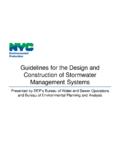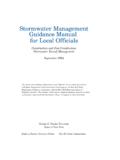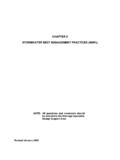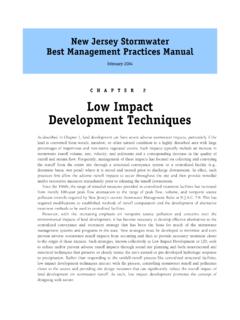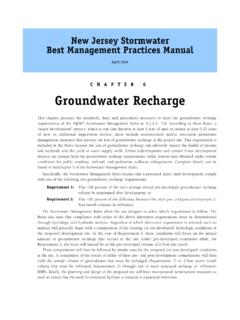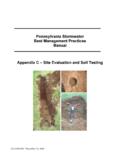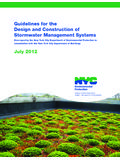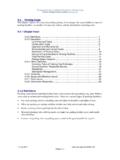Transcription of Handout 4 - Brochure 'Moving Dirt? Building …
1 stormwater Construction Permit Regulations NEW YORK STATE DEPARTMENT OF ENVIRONMENTAL CONSERVATION SPDES General Permit for stormwater Discharges from Construction Activity July 2008 If your project will impact, disturb or expose one or more acres of soil, including: Clearing and Grubbing Filling or Stockpiling Building Construction .. you are required to have a permit for stormwater discharges from the site. Grading Excavating Demolition MMoovvining g DDiirrtt?? Building Something? Building Something? The Problem with stormwater stormwater is water from rain or melting snow that doesn't soak into the ground but runs off into waterways. As stormwater flows from rooftops, over paved areas and lawns it picks up debris, chemicals, motor oil, animal waste and other pollutants. stormwater can flow into a storm sewer system or directly into a lake, stream, river or wetland, potentially contaminating the water we use for drinking, swimming and fishing.
2 Polluted runoff is the nation s greatest threat to clean water. stormwater carries the residue of urban living. Toxic chemicals from automobiles, sediment from construction activities, bacteria from animal wastes and careless application of pesticides and fertilizers threaten the health of the waterway and can kill fish and other aquatic life. stormwater Management stormwater management, especially in urban areas, is becoming a necessary step in seeking reductions in pollutants in our waterways and presents new challenges. More often than not, end-of-pipe controls are not the best answer for removing pollutants from stormwater runoff. Pollutants in runoff enter our waterways in numerous ways and the best method of control is usually at the pollutant's source. The US Environmental Protection Agency and the New York State Department of Environmental Conservation are addressing stormwater management in several ways.
3 A federal regulation, commonly known as stormwater Phase II, requires permits for stormwater discharges from Municipal Separate Storm Sewer Systems (MS4s) in urbanized areas and from construction activities disturbing one or more acres. To implement the law, the NYSDEC has issued two general permits, one for MS4s in urbanized areas and one for construction activities. The permits are part of the State Pollutant Discharge Elimination System (SPDES). Construction Permit Notice of Intent Section 402 of the Federal Clean Water Act requires permits for stormwater discharges from construction activities that disturb one or more acres of land. To obtain coverage under the SPDES General Permit for stormwater Discharges from Construction Activity, you must prepare a stormwater Pollution Prevention Plan (SWPPP) and submit a Notice of Intent (NOI) before beginning construction.
4 Mail your Notice of Intent to: NYS DEC Notice of Intent Bureau of Water Permits 625 Broadway, 4th Floor Albany NY 12233-3505 Note: A stormwater Pollution Prevention Plan must be prepared before submitting the NOI. If your project is in a regulated MS4, you must submit your NOI and SWPPP to the municipality. For More Information: Visit the DEC website at: If you don t have web access, you can obtain written material by calling your Regional DEC office below or your County Soil & Water Conservation District office. Region 1: (631) 444-0409 Region 6: (315) 785-2524 Region 2: (718) 482-4933 Region 7: (315) 426-7500 Region 3: (914) 332-1835 Region 8: (585) 226-5452 Region 4: (518) 357-2045 Region 9: (716) 851-7070 Region 5: (518) 623-1200 For a listing of Soil and Water Conservation Districts in New York State visit: Tools available from the DEC website: SPDES General Permit for stormwater Discharges from Construction Activity Permit Forms for download Notice of Intent (application for permit coverage) Notice of Termination MS4 SWPPP Acceptance Form Instruction Manual for stormwater Construction Permit (for preparing SWPPP and NOI) New York State Standards and Specifications for Erosion and Sediment Control (2005 ) New York State stormwater Management Design Manual (2003) NEW Chapter 9: Redevelopment Projects NEW Chapter 10.
5 Enhanced Phosphorus Removal stormwater Interactive Mapping Tool Technical guidance documents stormwater Pollution Prevention Plan The owner/operator must prepare a SWPPP - a plan for controlling runoff and pollutants from a site during and after construction activities. The principal objective of a SWPPP is to comply with the NY SPDES stormwater Permit for construction activities by planning and implementing the following practices: Reduction or elimination of erosion and sediment loading to waterways during construction Control of the impacts of stormwater runoff on the water quality of the receiving waters Control of the increased volume and peak rate of runoff during and after construction Maintenance of stormwater controls during and after completion of construction stormwater Impacts from the Construction Industry The construction industry is a critical participant in the nation s efforts to protect streams, rivers, lakes, wetlands and oceans.
6 Through the use of proper erosion and sediment control and stormwater management practices, construction site operators are the key defenders against stormwater impacts. Construction and development increase the amount of impervious surfaces in our watersheds, thus increasing runoff to waterways. The additional runoff results in increased erosion and sedimentation, and destroys aquatic habitat. Preventing soil erosion and sedimentation is an important responsibility at all construction sites. In addition to the environmental impacts, uncontrolled erosion can have a significant financial impact on a construction project. It costs money and time to repair gullies, replace vegetation, clean sediment-clogged storm drains, replace poorly installed practices and mitigate damage to other people s property or to natural resources.
7 Rain could easily wash this loose soil into the storm sewer and into a nearby stream, causing a water quality standards violation that could cost the site operator up to $37,500 each day it occurs. * Consult Appendix B of the General Permit for a complete listing of SWPPP requirements by project type ** Check the MS4 stormwater General Permit for maps of regulated MS4 boundaries, TMDL watersheds and impaired waterbody listings SWPPP and General Permit Sequence If your project will disturb or impact 1 or more acres of land and you are constructing a commercial, industrial or institutional Building , apartments, duplexes, a roadway, a single-family residential development with more than 25% impervious surfaces, a single-family development impacting 5 or more acres of land (including home construction); creating recreation areas, fill areas or linear utilities disturbing 5 acres or more*: Develop a stormwater Pollution Prevention Plan (SWPPP) with stormwater management practices in conformance with the New York State stormwater Management Design Manual and erosion and sediment controls in accordance with the New York State Standards and Specifications for Erosion and Sediment Control If your construction project is single-family residential with 25% or less impervious cover, a linear utility, recreation fields or fill area, and will impact between 1 and 5 acres of land (and the site is not located in a TMDL Watershed, or directly discharging to an impaired 303(d) waterbody**): Develop a SWPPP with erosion and sediment controls in accordance with the New York State Standards and Specifications for Erosion and Sediment Control If your project is located within a regulated MS4** 1.
8 Submit the SWPPP and Notice of Intent (NOI) to the municipality for review and acceptance 2. Submit the NOI and signed MS4 SWPPP Acceptance form to DEC in Albany 3. Begin construction 5 business days after notification from DEC of acceptance of NOI If your project is not located within a regulated MS4** 1. Submit a Notice of Intent (NOI) to the DEC in Albany 2. Begin construction 5 business days after notification from DEC of acceptance of NOI If the SWPPP deviates from the DEC technical design standards: 1. Submit a NOI to the DEC in Albany 2. Submit SWPPP to DEC Regional Office for review and acceptance prior to beginning construction When all construction has been completed and the site has been stabilized and fully vegetated: File a Notice of Termination (NOT) with the DEC stormwater retention ponds provide effective water quality control by using forebays for sediment settling, and have controlled-discharge outlets for flood control.
9 Important Terms Owner/Operator: The person or legal entity which owns or leases the property where construction will occur. Qualified Professionals: Professional Engineers, Landscape Architects and Certified Professionals in Erosion and Sediment Control are qualified to develop and certify SWPPPs and inspect construction sites. TMDL and 303(d) Waterbodies: Section 303(d) of the Clean Water Act requires states to identify Impaired Waters where specific designated uses are not fully supported. In order to restore and protect these Impaired Waters, Total Maximum Daily Loads (TMDLs) or other strategies have been developed to reduce the input of pollutants that restrict waterbody uses. Basic Components of a stormwater Pollution Prevention Plan* Narrative Report describing pre-development conditions and details of the planned project Maps illustrating site location, topography, drainage area, existing and proposed structures, erosion and sediment control and stormwater control measures Erosion and Sediment Control Plans Water Quality and Water Quantity Control Plans Construction Sequence Schedule Contractor Certification Statements Operations and Maintenance Schedule Weekly Inspection Reports * For a complete description of required SWPPP components please refer to the SPDES General Permit for stormwater Discharges from Construction Activity.
10

